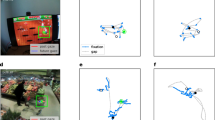Abstract
The design, performance, and application of The Real-time, Intelligently ControLled, Optical Positioning System (TRICLOPS) are described in this article. TRICLOPS is a multiresolution trinocular camera-pointing system which provides a center wide-angle view camera and two higher-resolution vergence cameras. It is a direct-drive system that exhibits dynamic performance comparable to the human visual system. The mechanical design and performance of various active vision systems are discussed and compared to those of TRICLOPS. The multiprocessor control system for TRICLOPS is described. The kinematics of the device are also discussed and calibration methods are given. Finally, as an example of real-time visual control, a problem in visual tracking with TRICLOPS is examined. In this example, TRICLOPS is shown to be capable of tracking a ball moving at 3 m/s, which results in rotational velocities of the vergence cameras in excess of 6 rad/s (344 deg/s).
Similar content being viewed by others
References
Abbott, A.L., and Ahuja, N. 1990. Active surface reconstruction by integrating focus, vergence, stereo, and camera calibration,Proc. 3rd Intern. Conf. Comput. Vis., Osaka, Japan, pp. 489–492.
Albus, J.S., McCain, H.G., and Lumia, R. 1987. NASA/NBS standard reference model for telerobot control system architecture (NASREM). National Inst. Standards and Technol., Gaithersburg, MD, Technical Note 1235.
Allen, P., Yoshimi, B., and Timcenko, A. 1990. Real-time visual servoing,Proc. DARPA Image Understanding Workshop, Pittsburgh, PA.
Aloimonos, J., and Shulman, D. 1989.Integration of Visual Modules: An Extension of the Marr Paradigm. Academic Press: New York.
Aloimonos, J., Weiss, I., and Bandyopadhyay, A. 1987. Active vision,Proc. 1st Intern. Conf. Comput. Vis., London, pp. 35–54.
Aspex, Inc. 1987. PIPE—An introduction to the PIPE system. New York.
Bajcsy, R. 1988. Active perception,Proc. IEEE 76(8): 966–1005.
Ballard, D.H. 1991. Animate vision,Artificial Intelligence 48: 57–86.
Ballard, D., and Azcandarli, A. 1988. Eye fixation and early vision: Kinetic depth,Proc. 2nd Intern. Conf. Comput. Vis., Tampa, FL, pp. 524–531.
Bederson, B.B., Wallace, R.S., and Schwartz, E.L. 1992. Two miniature pan-tilt devices,Proc. Intern. Conf. Robot. Autom., pp. 658–663.
Brown, C.M. 1989. Kinematic and 3D motion prediction for gaze control.Proc. Workshop on Interpretation of 3D Scenes, Austin, TX, pp. 145–151.
Carpenter, R.H.S. 1988.Movements of the Eyes. Pion Limited: London, England.
Chaconas, K., Kelmar, L., and Nashman, M. 1990. A NASREM implementation of position determination from motion. National Inst. Standards and Technol., Gaithersburg, MD, Internal Report 90-4286.
Clark, J.J., and Ferrier, N.J. 1988. Modal control of an attentive vision system,Proc. 2nd Intern. Conf. Comput. Vis., Tampa, FL, pp. 514–523.
Fiala, J. 1989. Note on NASREM implementation. National Inst. Standards and Technol., Gaithersburg, MD, Internal Report 89-4215.
Fiala, J., Wavering, A., and Lumia, R. 1992. A manipulator control testbed: Implementation and applications,Proc. AAS Conf. Guidance and Control, Keystone, CO.
Geiger, D., and Yuille, A. 1989. Stereo and eye movement,Biological Cybernetics 62: 117–128.
James, M.L., Smith, G.M., and Wolford, J.C. 1977.Applied Numerical Methods for Digital Computation. Harper & Row: New York.
Krotkov, E., Fuma, F., and Summers, J. 1988. An agile stereo camera system for flexible image acquisition.IEEE J. Robot. Autom. 4(1): 108–113.
Olson, T.J., and Coombs, D.J. 1991. Real-time vergence control for binocular robots,Intern. J. Comput. Vis. 7(1): 67–89.
Pahlavan, K., and Eklundh, J.O. 1992. A head-eye system-Analysis and design,Comput. Vis., Graph., Image Process.: Image Understanding 56(1): 41–56.
Poggio, T., et al. 1988. The MIT vision machine,Proc. DARPA Image Understanding Workshop, pp. 177–198.
Robinson, D.A. 1987. Why visuomotor systems don't like negative feedback and how they avoid it. In Michael Arbib and Allen Hanson, eds.,Vision, Brain, and Cooperative Computation. MIT Press: Cambridge, MA.
Schwab, E.C., and Nusbaum, H.C., eds. 1986.Pattern Recognition by Humans and Machines, Vol. 2, Visual Perception. Academic Press: New York.
Swain, M.J., and Stricker, M., eds. 1991. Promising directions in active vision. Report from the NSF Active Vision Workshop, University of Chicago.
Tsai, Roger Y. 1987. A versatile camera calibration technique for high-accuracy 3D machine vision metrology using off-the-shelf TV cameras and lenses,IEEE J. Robot. Autom. RA-3(4): 323–344.
Wavering, A J., and Lumia, R. 1993. Predictive visual tracking.Proc. SPIE Intelligent Robots and Machine Vision XII: Active Vision and 3D Methods, SPIE vol. 2056, Boston, MA, pp. 86–97.
Webb Associates, eds. 1978.Anthropometric Source Book, Vol. I:Anthropometry for Designers, NASA Reference Publication 1024.
Wurtz, R.H., and Goldberg, M.E., eds. 1989.The Neurobiology of Saccadic Eye Movements. Elsevier: New York.
Author information
Authors and Affiliations
Rights and permissions
About this article
Cite this article
Fiala, J.C., Lumia, R., Roberts, K.J. et al. TRICLOPS: A tool for studying active vision. Int J Comput Vision 12, 231–250 (1994). https://doi.org/10.1007/BF01421204
Received:
Revised:
Issue Date:
DOI: https://doi.org/10.1007/BF01421204




